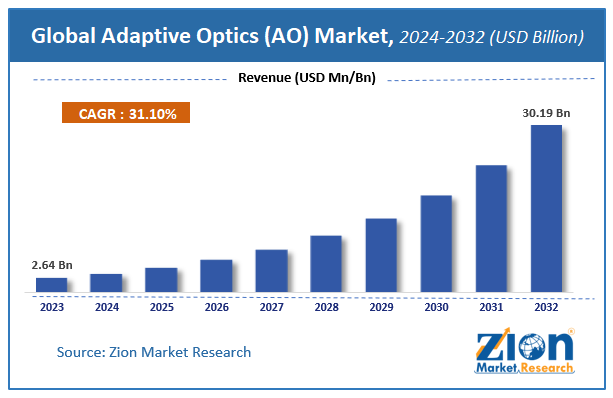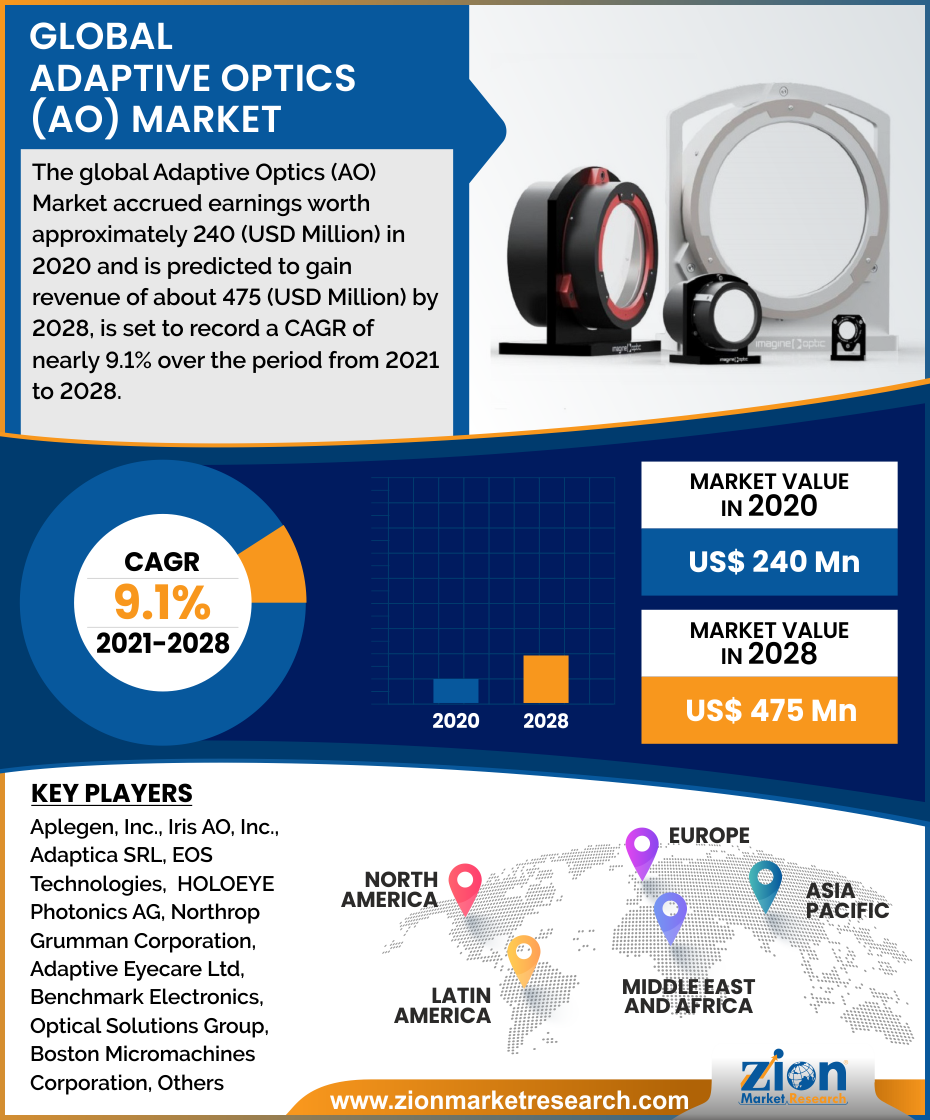Adaptive Optics (AO) Market Size, Share, Trends, Growth and Forecast 2032

Adaptive Optics (AO) Market - By Type (Next Generation Adaptive Optics (NGAO), Ground Layer Adaptive Optics (GLAO), Multi-Conjugate Adaptive Optics (MCAO), and Multi Object Adaptive Optics (MOAO)), By Component (Wavefront Sensor, Control System, And Wavefront Modulator) And By End-Use Industry (Communication, Industrial & Manufacturing, Military & Defense, Consumer, and Biomedical): Global Industry Perspective, Comprehensive Analysis And Forecast, 2024 - 2032-
| Market Size in 2023 | Market Forecast in 2032 | CAGR (in %) | Base Year |
|---|---|---|---|
| USD 2.64 Billion | USD 30.19 Billion | 31.1% | 2023 |
Adaptive Optics (AO) Market Insights
According to a report from Zion Market Research, the global Adaptive Optics (AO) Market was valued at USD 2.64 Billion in 2023 and is projected to hit USD 30.19 Billion by 2032, with a compound annual growth rate (CAGR) of 31.1% during the forecast period 2024-2032.
This report explores market strengths, weakness, opportunities, and threats. It also provides valuable insights into the market's growth drivers, challenges, and the future prospects that may emerge in the Adaptive Optics (AO) Market industry over the next decade.
Adaptive Optics (AO) Market Size
The report offers assessment and analysis of the Adaptive Optics (AO) Market on a global and regional level. The study offers a comprehensive assessment of the market competition, constraints, revenue estimates, opportunities, evolving trends, and industry-validated data. The report provides historical data from 2018 to 2022 along with a forecast from 2024 to 2032 based on revenue (USD Million).
Adaptive Optics (AO) Market: Overview
Adaptive optics is a method that helps in removing atmospheric disturbance along with assisting telescope in achieving diffraction-restricted imaging from land surface. Moreover, it is utilized in enhancing optical system performance through minimization of incoming wave front distortion effect by mirror deformation for distortion compensation. Apart from this, adaptive optics functions through measuring of distortions in a wave front and compensates them with equipment correcting these errors including liquid crystal array and deformable mirror. Additionally, adaptive optics is considered as a best alternative for enhancing optical system performance.
Adaptive optics (AO) is a technology in which optical performance is enhanced by quickly manipulating the shape of a lens or mirror to correct for unwanted disturbances (or to introduce desired disturbances). Adaptive optics systems usually consist of three subsystems a wavefront modulator, to correct distortions in the wavefront; wavefront sensor, to detect the state of the wavefront; and a control system to link the two.
A major strength of Adaptive optics (AO) is its application adaptability. Most of the world’s major telescopes such as the European Southern Observatory (ESO) in Chile and Keck Observatory in Hawaii, rely on AO to take away wavefront distortion caused by atmospheric turbulence to provide clear images of stars and extra-solar planets. Integration of adaptive optics by a biological researcher into microscopes for proper wavefront aberrations introduced by tissue and hence extracting vital information from specimens is predicted to contribute the growth of AO market massively in years to come. Furthermore, use of AO by vision science in their efforts to detect eye disease before its onset and begin earlier treatment. Finally, laser applications for example laser beam shaping for free space communication and laser machining have been successfully established with AO.
Adaptive Optics (AO) Market: Growth Drivers
The rise in the occurrence of retinal degenerating disorders has culminated in the humungous use of adaptive optics, thereby driving market trends. Reportedly, in 2014, nearly 171 million persons were affected by age-related macular degeneration and retinitis pigmentosa. In addition to this, a number of people impacted due to related macular degeneration is set to increase to nearly 289 million by 2040. Apparently, an adaptive optics fundus camera assists in the observation of disruptions in the cone mosaic of retinitis pigmentosa patients. Furthermore, the rise in the use of adaptive optics in clinics & research activities will boost the adaptive optics (AO) market surge.
In addition to this, adaptive optics is also used with optical coherence tomography for enhancing high-speed imaging activities. Apart from this, technological breakthroughs in adaptive optics instruments are projected to open new vistas of growth for adaptive optics (AO) market. However, high costs of adaptive optics tools is likely to reduce its acceptance in emerging economies, thereby putting brakes on expansion of adaptive optics (AO) industry.
The global adaptive optics market is primarily driven by increasing use in ophthalmology and retinal imaging. In addition, rising adoption of adaptive driver-assistance systems (ADAS) in automobiles paired with increased research investment and funding by government tends to spur adaptive optics demand significantly in coming years. Furthermore, increasing demand of adaptive optics for high-resolution microscopy, growing value for utilizing adaptive optics in free-space laser communications and utilization of adaptive optics for long-range target identification in military applications are some of the major factors predicted to drive the global adaptive optics market growth. On a contrary, rapidly changing technologies is expected to have an adverse impact on adaptive optics market growth. Nonetheless, advancing adaptive optics technology coupled with development in professional astronomy may disclose new avenues for adaptive optics market in the near future.
Adaptive Optics (AO) Market: Regional Landscape
North America To Account Majorly Towards Regional Market Size Over 2024-2032
Expansion of adaptive optics (AO) market in North America over forecast timeframe can be credited to large-scale use of new technologies in the biomedical industry in Canada and the U.S. In addition to this, rise in research activities pertaining to adaptive optics in myriad research units and institutes will prop up a regional market size in ensuing years. Presence of reputed players in sub-continent can generate lucrative prospects for adaptive optics (AO) market growth in North America.
North America and Europe together held the majority of market share of the global adaptive optics market and is set to continue to dominate the world marketplace within the coming years. The major factors driving the growth of the market are rapid advancements in adaptive optics coupled with increasing demand for military and defense application. Presence of significant market player in both the region is predicted to shape the adaptive optics market massively. Increasing research & development activities is the major driving factor for the growth of adaptive optics markets in Asia Pacific region. Asia Pacific is expected to hold remarkable market share and expected to grow with highest CAGR during the analysis period.
Adaptive Optics (AO) Market: Report Scope
| Report Attributes | Report Details |
|---|---|
| Report Name | Adaptive Optics (AO) Market |
| Market Size in 2023 | USD 2.64 Billion |
| Market Forecast in 2032 | USD 30.19 Billion |
| Growth Rate | CAGR of 31.1% |
| Number of Pages | 188 |
| Key Companies Covered | Aplegen, Inc., Iris AO, Inc., Adaptica SRL, EOS Technologies, HOLOEYE Photonics AG, Northrop Grumman Corporation, Adaptive Eyecare Ltd, Benchmark Electronics, Optical Solutions Group, Boston Micromachines Corporation, Phasics Corporation, Synopsys Schott North America Inc., Baker Adaptive Optics, and Sacher Lasertechnik Group |
| Segments Covered | By Type, By End-Use Industry, By Component and By Region |
| Regions Covered | North America, Europe, Asia Pacific (APAC), Latin America, Middle East, and Africa (MEA) |
| Base Year | 2023 |
| Historical Year | 2018 to 2022 |
| Forecast Year | 2024 - 2032 |
| Customization Scope | Avail customized purchase options to meet your exact research needs. Request For Customization |
Adaptive Optics (AO) Market: Competitive Landscape
Key participants influencing market growth and included in report are -
- Aplegen
- Iris AO
- Adaptica SRL
- EOS Technologies
- HOLOEYE Photonics AG
- Northrop Grumman Corporation
- Adaptive Eyecare Ltd
- Benchmark Electronics
- Optical Solutions Group
- Boston Micromachines Corporation
- Phasics Corporation
- Synopsys Schott North America Inc.
- Baker Adaptive Optics
- Sacher Lasertechnik Group.
The global Adaptive Optics (AO) Market is segmented as follows:
By Type
- Next Generation Adaptive Optics (NGAO)
- Ground Layer Adaptive Optics (GLAO)
- Multi-Conjugate Adaptive Optics (MCAO)
- Multi-Object Adaptive Optics (MOAO)
By End-Use Industry
-
Communication
- Industrial & Manufacturing
- Military & Defense
- Consumer
- Biomedical
By Component
- Wavefront Sensor
- Wavefront Modulator
- Control System
By Region
- North America
- The U.S.
- Canada
- Europe
- France
- The UK
- Spain
- Germany
- Italy
- Rest of Europe
- Asia Pacific
- China
- Japan
- India
- South Korea
- Southeast Asia
- Rest of Asia Pacific
- Latin America
- Brazil
- Mexico
- Rest of Latin America
- Middle East & Africa
- GCC
- South Africa
- Rest of Middle East & Africa
Table Of Content
Methodology
FrequentlyAsked Questions
Rise in occurrence of retinal degenerating disorders has culminated into humungous use of adaptive optics, thereby driving market trends. Reportedly, in 2014, nearly 171 million persons were affected from age-related macular degeneration and retinitis pigmentosa. In addition to this, number of people impacted due to related macular degeneration is set to increase to nearly 289 million by 2040. Apparently, an adaptive optics fundus camera assists in observation of disruptions in cone mosaic of retinitis pigmentosa patient. Furthermore, rise in use of adaptive optics in clinics & research activities will boost adaptive optics (AO) market surge.
In addition to this, adaptive optics is also used with optical coherence tomography for enhancing high-speed imaging activities. Apart from this, technological breakthroughs in adaptive optics instruments are projected to open new vistas of growth for adaptive optics (AO) market.
Adaptive Optics (AO) Market size worth at USD 2.64 Billion in 2023 and projected to USD 30.19 Billion by 2032, with a CAGR of around 31.1% between 2024-2032.
North America will contribute lucratively towards the global market earnings over the projected timeline. The regional market surge is subject to large-scale use of new technologies in biomedical industry in Canada and the U.S. In addition to this, rise in research activities pertaining to adaptive optics in myriad research units and institutes will prop up regional market size in ensuing years. Presence of reputed players in sub-continent can generate lucrative prospects for adaptive optics (AO) market growth in North America.
The key market participants include Aplegen, Inc., Iris AO, Inc., Adaptica SRL, EOS Technologies, HOLOEYE Photonics AG, Northrop Grumman Corporation, Adaptive Eyecare Ltd, Benchmark Electronics, Optical Solutions Group, Boston Micromachines Corporation, Phasics Corporation, Synopsys Schott North America Inc., Baker Adaptive Optics, and Sacher Lasertechnik Group.
Choose License Type
RelatedNews
HappyClients
Zion Market Research
Tel: +1 (302) 444-0166
USA/Canada Toll Free No.+1 (855) 465-4651
3rd Floor,
Mrunal Paradise, Opp Maharaja Hotel,
Pimple Gurav, Pune 411061,
Maharashtra, India
Phone No +91 7768 006 007, +91 7768 006 008
US OFFICE NO +1 (302) 444-0166
US/CAN TOLL FREE +1 (855) 465-4651
Email: sales@zionmarketresearch.com
We have secured system to process your transaction.
Our support available to help you 24 hours a day, five days a week.
Monday - Friday: 9AM - 6PM
Saturday - Sunday: Closed








